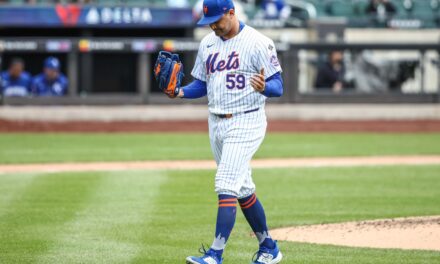
Stat Line: 8 IP, 1 R, 4 H, 8 SO, 1 BB
Logan Verrett showed more than scouts prepared us for, exhibiting an above average breaking ball while keeping four pitches low in the strike zone. Based on his performance, Verrett will add much needed depth to the New York Mets bullpen.
Repertoire
Verrett’s breaking ball (slider and curveball) is a viable MLB strikeout pitch, inducing an extremely high 31.4% miss/whiff rate (swing and miss rate). The breaking ball shows sharp, late, downward movement and has enough velocity to deceive the hitter into thinking the pitch is a four-seam fastball. The reason behind defining it as a breaking ball is because it’s tough to decipher the difference between his slider and curveball.
At times, Verrett’s two-seam fastball seemed to move 10 to 14 inches with sharp 10 to 5 downward movement. Although he didn’t show consistent fastball command on the corners of home plate, Verrett kept his pitches between ankle and thigh high.
Staying low in the strike zone with two pitches having sharp downward movement makes it nearly impossible for opposing hitters to lift the baseball for hard hits and extra base hits.
Cause for Concern
Verrett showed a stronger out pitch than scouts reported but didn’t exhibit fastball command on each corner of home plate needed for a pitcher throwing in the low 90’s. This makes him vulnerable to higher homerun rates and more walks.
The Colorado Rockies over aggressive swings at pitches in and out of the strike zone helped mask Verrett’s command. A veteran lineup, like the St. Louis Cardinals, will take more pitches and more controlled swings leading to more walks, more singles and more runs.
Another reason to view his debut cautiously is he did an average job throwing first pitch strikes (64% first pitch strike rate) and mixing his pitch selection. Verrett only threw 35% first pitch off-speed pitches. I want to see Verrett pitch backward more often for a pitcher throwing 90 mph fastballs with average command.
Looking Forward
Given the Mets exceptional starting rotation, Verrett is a spot-starter and above average reliever. Although he might be slightly better than Bartolo Colon, Verrett can easily translate to an above average reliever whereas Colon cannot. Also, Verrett will not start in the playoffs so it is better the Mets train him in the role he will be most productive in during playoffs, as a reliever.
There are two reasons Verrett will be a solid bullpen option. His two-seamer inducing groundballs coupled with his strikeout ability with the sharp breaking ball gives Verrett the ability to get out of late inning jams. Additionally, Terry Collins can take out a struggling starter in earlier innings with Verrett able to bridge the middle innings to Tyler Clippard and Jeurys Familia.
Stat of the Night
I need to reiterate Verrett’s exceptional miss/whiff rate of 31.4% with his breaking ball (slider and curveball combined rate).
Follow Chris Zaccherio on Twitter @ziography for more Mets pitching insight that goes beyond statistics.














